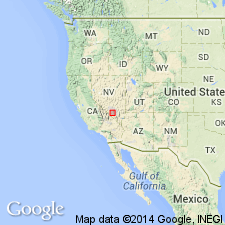
- Usage in publication:
-
- Dead Horse Flat Formation*
- Modifications:
-
- Named
- Geochronologic dating
- Dominant lithology:
-
- Tuff
- Lava
- AAPG geologic province:
-
- Great Basin province
Summary:
Named for an area of low relief within Dead Horse Flat quad, Nye Co, NV, Great Basin province. Occurs in subsurface; type section is drillhole UE-19c in Pahute Mesa from depths of 2377-7380 ft. Assigned to Belted Range Group (revised) as uppermost of two formally named formations. Consists of peralkaline lava flows and related tuffs which filled and overflowed the Grouse Canyon caldera of the Silent Canyon caldera complex. At type overlies Grouse Canyon Tuff (revised) of Belted Range and underlies Bullfrog Tuff (revised) of Crater Flat Group (revised); on nomenclature chart (table 1) Dead Horse Flat shown to be younger than Tram Tuff (revised) of Crater Flat which is shown to occur below Bullfrog. Equivalent to volcanics of Saucer Mesa of Sawyer and Sargent (1989, Jour. of Geophysical Res., v. 94, p. 6021-6040) which are exposed north of Silent Canyon caldera complex. 40Ar/39Ar age of 13.5 +/-0.02 Ma (Miocene) was determined from sanidine (table 3).
Source: GNU records (USGS DDS-6; Denver GNULEX).
For more information, please contact Nancy Stamm, Geologic Names Committee Secretary.
Asterisk (*) indicates published by U.S. Geological Survey authors.
"No current usage" (†) implies that a name has been abandoned or has fallen into disuse. Former usage and, if known, replacement name given in parentheses ( ).
Slash (/) indicates name conflicts with nomenclatural guidelines (CSN, 1933; ACSN, 1961, 1970; NACSN, 1983, 2005, 2021). May be explained within brackets ([ ]).

